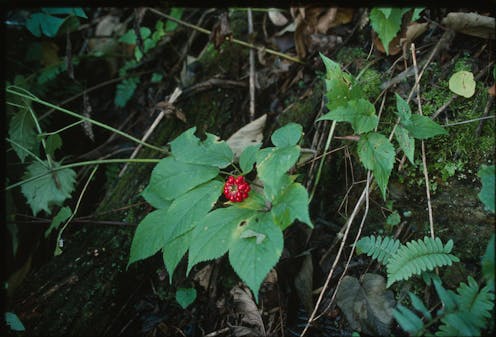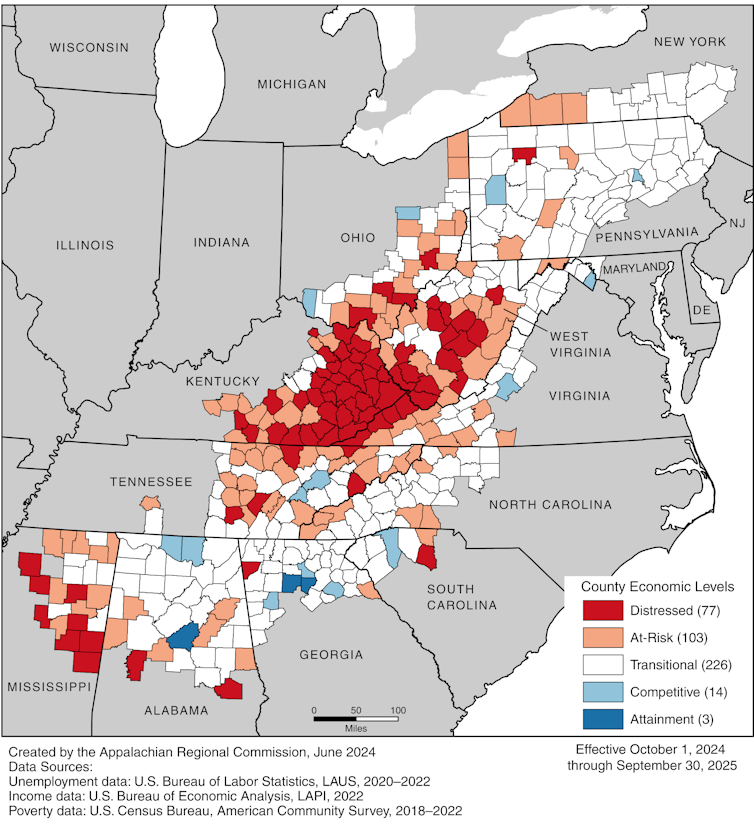Wild ginseng is declining, but small-scale ‘diggers’ aren’t the main threat to this native plant − a
There’s a widespread argument that ‘poachers’ are responsible for the scarcity of wild ginseng. But a scholar who has interviewed diggers explains that most of them are good stewards.

Across Appalachia, September marks the start of ginseng season, when thousands of people roam the hills searching for hard-to-reach patches of this highly prized plant.
Many people know ginseng as an ingredient in vitamin supplements or herbal tea. That ginseng is grown commercially on farms in Wisconsin and Ontario, Canada. In contrast, wild American ginseng is an understory plant that can live for decades in the forests of the Appalachian Mountains. The plant’s taproot grows throughout its life and sells for hundreds of dollars per pound, primarily to East Asian customers who consume it for health reasons.
Because it’s such a valuable medicinal plant, harvesting ginseng has helped families in mountainous regions of states such as Kentucky, West Virginia, Tennessee, North Carolina and Ohio weather economic ups and downs since the late 1700s.
Most harvesting takes place in Appalachia’s long-enduring forest commons – forests across the region that historically were managed and used by local residents. Many people in Appalachia still believe that, at least in practice, forests should be common property, even as large swaths of the region’s forests have been placed under state or federal ownership over the past century.
Recently, however, it has become harder for diggers to harvest ginseng from public lands, such as national forests. Those who flout regulations are receiving steeper fines and, sometimes, prison sentences.

This is because ginseng populations are hovering at a fraction of their historical levels. Government agencies, scholars and the media have asserted that contemporary diggers have overharvested wild ginseng from Appalachia’s forests.
I’m an environmental geographer who studies rural livelihoods and conservation in North American forests. As I see it, large-scale threats to ginseng, including mining and climate change, are bigger concerns than small-scale harvesting by negligent diggers. I believe many diggers can be valuable conservation partners.
Ginseng and law enforcement
Ginseng was listed in Appendix II of the Convention on International Trade in Endangered Species of Wild Fauna and Flora in 1975. This indicated that the plant was not threatened at the time but could become so. Today, ginseng is classified as vulnerable in 13 of the 19 states that allow its harvest and sale, subject to state regulations.
Some of those regulations include:
– A harvest season from Sept. 1 through late fall
– Harvesting bans on certain types of land, such as state parks and wildlife refuges
– A requirement that harvested plants must have three leaves, or “prongs,” a proxy for the plant’s age
– A requirement that diggers plant the berries from ginseng they’ve dug at the harvest site
Over the past decade, state and federal agencies have tightened ginseng regulations and ramped up enforcement. These actions were spurred largely by rising ginseng prices and by evidence that ginseng was sometimes sold on black markets in exchange for illegal drugs.
In 2018, for instance, West Virginia increased fines for illegal ginseng harvesting from US$100 to between $500 and $1,000 for a first offense. That same year, Ohio began using K-9 dogs to detect ginseng held by people suspected of illegal digging.
States with sizable ginseng harvests often conduct undercover and sting operations to detect illegal harvesting. Some national parks and preserves even dye or attach microchips to ginseng plants to make illegal collection easier to spot.
Meanwhile, the U.S. Forest Service has indefinitely suspended ginseng harvesting in national forests in Kentucky, North Carolina, Georgia and Tennessee. These closures cover over 5,000 square miles (13,000 square kilometers) of Appalachian forestland – an area larger than the state of Connecticut.
Broader threats
Stricter enforcement has increased ginseng-related convictions in states across Appalachia. Many people who have been fined or incarcerated are dealers or other linchpins in illegal ginseng supply chains.
According to wildlife officers I’ve spoken with, however, many arrests are of diggers who don’t follow regulations precisely and who might, for instance, harvest sustainably but on closed land. Typically, these diggers still see the forest as a commons that everyone should be able to access and don’t think contemporary ginseng regulations are fair or useful.
Some scholars call this phenomenon “folk crime,” a catchall phrase for widely tolerated offenses such as jaywalking in cities or harvesting wildlife in rural areas.

My archival and ethnographic research shows that ordinary diggers have been blamed for the scarcity of ginseng since at least the late 1800s. In a 1903 book, for example, horticulturalist M.G. Kains argued that “the principal agents in the extermination of the native supply are the ginseng diggers … they exercise no judgment.”
But diggers are not, and never have been, the only reason for small ginseng populations. Starting in the late 1800s, forests across virtually all of the eastern United States were logged for farming, fuel and industry.
In the past 30 years, over 2,300 square miles (6,000 square kilometers) in central Appalachia have been surface-mined for coal. This technique removes all plants, soil and rock at the earth’s surface to access coal just beneath it. Surface mining also buries streams under displaced earth and rock, degrades water quality and can lead to loss of large tracts of forestland.
Ginseng patches have also been razed for housing developments and overgrazed by white-tailed deer. And climate change is making winters warmer and extreme rainfall events more frequent throughout the central Appalachians, altering growing conditions.
Diggers can support conservation
I have interviewed dozens of ginseng diggers. Nearly all of them harvest only a portion of the plants in a patch, and they will wait until a plant’s berries are ripe before they dig it up and replant the berries.
Some diggers tend secret, secluded ginseng patches for many years. Others have purchased and planted seeds to establish new populations. A 2016 study found that digger-planted seeds germinate at much higher rates than seeds that fall naturally on the forest floor.
Other researchers have also highlighted diggers’ conservation practices, the complex pressures on ginseng populations and the injustice of excluding Appalachians from their historical forest commons. Still, the “crooked digger” narrative persists.
A different way forward could involve diggers in ginseng restoration on a broad scale. There’s already a robust movement to plant ginseng seeds under existing forest canopy on private land, but most diggers don’t own land. A complementary effort might distribute seeds to them for planting in designated zones. Participating could be a way to earn ginseng harvesting permits in state or national forests.
Threats to ginseng across Appalachia are a legitimate concern, and curbing profligate overharvesting is important. But diggers helped facilitate the existence and persistence of ginseng populations, and they could be knowledgeable, skillful conservation allies. In my view, casting them as villains and barring them from nearly all public land is both unjust and ineffective.
Justine Law does not work for, consult, own shares in or receive funding from any company or organization that would benefit from this article, and has disclosed no relevant affiliations beyond their academic appointment.
Read These Next
The ‘one chatbot per child’ model for AI in classrooms conflicts with what research shows: Learning
AI tutors are often held up as an ideal, but prioritizing individualized teaching can detract from the…
Christmas trees are more expensive than ever in Colorado — what gives?
Most Christmas trees are imported from other states, which drives up costs.
Getting peace right: Why justice needs to be baked into ceasefire agreements – including Ukraine’s
Just war theory, a centuries-old field of ethics, deals with how and when to start conflicts. It can…






